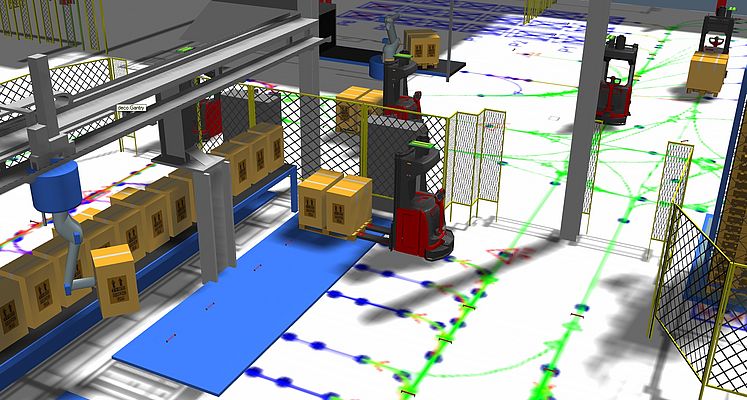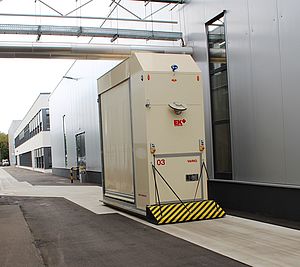From automotive to food and beverage, from pharmaceutical to packaging systems - in nearly all industries, more and more processes such as the transport of goods, load handling, picking and assembly have been automated. Innovative transport robotics systems ensure that the right products are transported to the right place at the right time. Modern Automated Guided Vehicle systems (AGV) perform this task quick and reliable. But how can such a concept be optimally planned? Numerous factors, such as traffic tracks, the number of vehicles, system cycle times and many others must be brought together and coordinated perfectly in order to create an efficient system that delivers the desired performance. So, it is worthwhile to enlist the support of experts.
E&K Automation GmbH with its headquarters in Rosengarten in Lower Saxony, Germany, and with its about 180 employees worldwide specialises in the automatization of materials handling and storage systems with their state-of the art transport robots technology. The company, which is one of the leading AGV and transport robots suppliers on the European market, develops intelligent and efficient transport solutions for a wide range of transport tasks. More and more customers rely on the long lasting experience of the specialists at EK Automation and demand for an individual concept on behalf of the simulations - another big business field of the company. Simulation means to create a 2D or 3D model of the customer’s facilities, in which many different processes are visualised and simulated - always in order to get the optimal solution and to detect potential problems in advance. This makes it possible to customise the transport concept exactly according to building surroundings and to achieve maximum productivity - and to prevent costly “surprises” due to bad planning. How the expert simulation team works in these projects is explained by Florian Johannsen, Team Leader Consulting & Simulation at E&K Automation GmbH: “We use Tecnomatix Plant Simulation from Siemens, a special simulation software for creating such models. On the basis of this software, we developed a special modular system for fast and effective visualisation of many different processes.” For a 2D or 3D simulation, the experts at EK Automation are in need of very exact layout data, such as blueprints of the facilities, the location and dimensions of systems, shelves, etc. This data will be matched together with the data for the desired Automated Guided Vehicles (AGV) designed by EK Automation, with the data of the company processes’ and the data of the required transport tasks. Further important information includes transport flows and their fluctuations throughout the day. Buffer sizes and machine behaviour in adjacent areas are also taken into account. A 2D or 3D model is then created on the basis of this information. “In our planning, the layout data has to be accurate down to the centimetre; deviations would cause problems. The more exact the data we work with are, the more reliable are the final results,” emphasises Florian Johannsen.
Laser scanner measurements for exact data material
Sometime it could happen that the existing documents are not usable - for example, if blueprints from an older production building are not accurate - EK Automation meanwhile offers the service of measuring the facilities down to the millimetre. “For this purpose we use a special laser scanner,” Florian Johannsen explains. The state-of-the-art 3D laser scanner allows us to measure the entire visible environment of a room and to visualise it in a three-dimensional digital model. Numerous single scans are combined to create a so-called point cloud of a room, which shows the exact layout of the measured objects. The experts at EK Automation use this data to create an overall model of the room in 2D or 3D view on the computer. This method enables the documentation of the interiors of large and complex buildings with high precision. Non-contact measurement of shapes and distances even makes it possible to measure remote areas that are difficult to access. The collected data, such as lengths, dimensions
of walls, passageways, windows or doors, and many other specifications, are then available “on click” for creating simulations and for a future implementation of the transport robotics concepts. In the numerous possibilities that are analysed by using the model, there are two major unknown facts that can only be determined on behalf of the simulation: the empty runs of the transport vehicles and the potential traffic jams. The simulation’s purpose is to identify and minimise these factors. Furthermore, the visualisation of natural fluctuations can be only seen via the simulation. So very often it is necessary to consider other factors that have little or nothing to do with the actual transport system and that affect the entire material flow process, such as the cycle time of the systems, the speed or the buffer capacity of the conveyor belts. When planning a new system, the simulation makes it possible to compare different concepts and to develop diverse transport strategies. But simulations are also used for existing systems. For example, that makes it possible to determine exactly where to look for the bottlenecks in the system.
Early identification of planning risks
The special strength of the simulation is the ability to visualise processes in fast motion from a bird’s eye view: Even non-experts can easily understand complicated transport tasks if the analysis of the processes is monitored at 50 to 100 times speed. That fact facilitates cooperation and understanding between the specialists and their customers. “In close cooperation with our clients we can use this system to analyse bottlenecks and optimise batch sizes as well as the sequences of orders. It is also possible to identify the limits of a system in the case of extension plans. Users learn whether the implementation of a desired system can be realised with only minimal modifications or whether more extensive measurements must be undertaken. It is also possible to check different transport strategies. In addition, our customers use the simulation if they want to make sure that the transport processes will still operate after a system alteration,” the expert explains. He adds: “Of course, it is best to create the simulation as early as possible. Because a concept for such an AGV system affects many sectors - from shelf suppliers to machine manufacturers. If everything is coordinated down to the last detail, the material flow will work optimally. It is therefore possible to make corrections at many points before unnecessary costs may arise due to a bad planning.”
Since 2014 the simulation team at EK Automation has already implemented more than 60 projects, each within a period of one to ten weeks, depending on the complexity. Once a simulation model has been created for the client, it is a versatile tool that can be used for future optimisation of the set-up sequence in systems. Arla Foods in UK, the biggest global dairy manufacturer, even invested in its own licenses for the software. The specialists in Rosengarten customised the simulation for the manufacturer’s plant in England so that the company’s employees - trained by the EK simulation team - can try out how the transport system reacts up to changes in specific data of the highly coordinated material flow process.



















